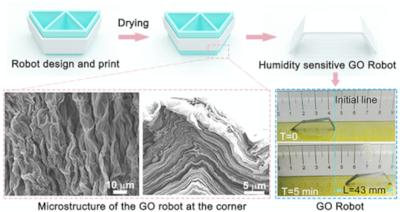Researchers from China’s Harbin Institute of Technology have 3D printed a soft robot from graphene-oxide that is capable of moving backward and forwards when exposed to moisture.

The scientists combined Direct Ink Writing (DIW) 3D printing and constrained drying techniques to fabricate the soft robot, and were able to overcome the porosity, shrinkage and structure uniformity challenges previously observed when 3D printing graphene-oxide objects.
Freeze-drying techniques are typically used to maintain the uniformity of 3D printed graphene-oxide structures, however this can leave the structures highly porous. In order to overcome this effect, the researchers proposed to control the shrinkage process of the 3D printed graphene-oxide gel through a combination of DIW 3D printing and constrained drying techniques.
The scientists began by ensuring the rheological properties of the graphene-oxide ink were optimized to allow for both smooth extrusion during the DIW process and shape stability of the printed objects. To achieve this, they ensured the ink contained highly-aligned and densely compacted graphene-oxide sheets.
To prevent deformation during the drying phase, the researchers employed 3D printed constraints that could be easily controlled to ensure uniform shrinkage across the entire structure. This meant that the graphene-oxide sheets remained aligned and compacted throughout the drying process, enabling the printed structure to hold its shape.
The scientists were also able to control the angle at the corner of the 3D constraints, as well as the humidity of the local environment, to demonstrate the actuation capability of their 3D printed graphene-oxide soft robot. By alternatively dropping water droplets on each of the soft robot’s ‘legs’, it was able to move backward and forwards without any external power supply.
According to the researchers, the successful combination of DIW 3D printing and constrained drying has formed the basis of a versatile platform to develop future graphene-oxide soft robots that are sensitive to changes in moisture and humidity.